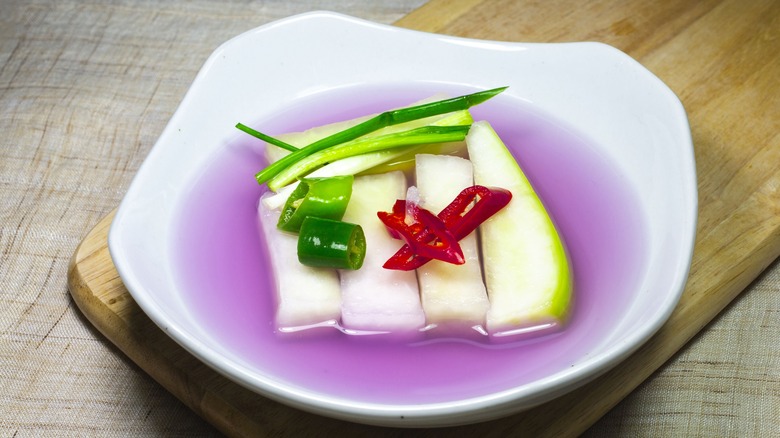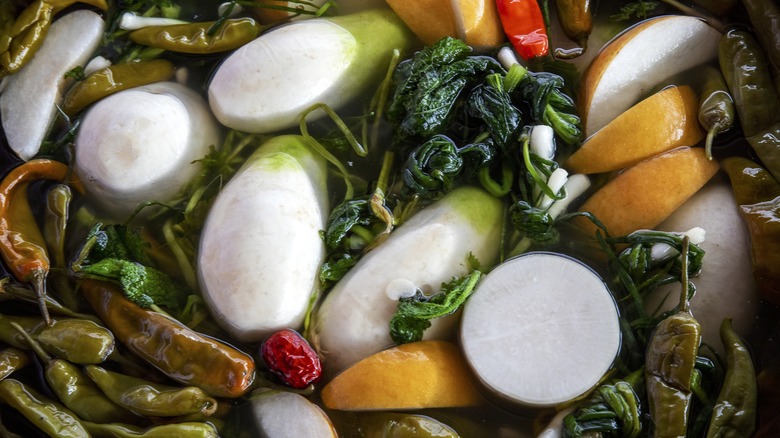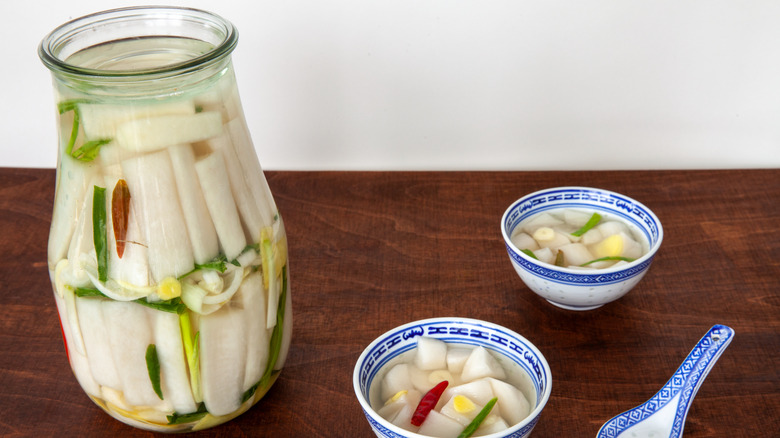If You Want To Try Kimchi But Can't Do The Spice, Go For Dongchimi
Korea's national dish, kimchi, is spicy and savory, with notes of garlic and ginger. Although it's somewhat similar to sauerkraut, it typically delivers more heat, more spice, and a stronger umami flavor. But there's an alternative for those who can't handle the heat: it's called dongchimi, also known as radish water kimchi. This briny variety of kimchi consists of crunchy white radish, crisp pears, green onions, and seasonings in a salted water brine.
A traditional Korean dish, dongchimi has a mild flavor without the spiciness of conventional napa cabbage kimchi. Its history dates back to the Goryeo dynasty, a time when Korean cooks didn't use chili powder in their food. Dongchimi became a staple of their cuisine, and its brine was thought to have therapeutic benefits. In the past, it was used as a natural treatment for dyspepsia. Many dongchimi lovers also prize white radish, its main ingredient, for its potential health benefits and help in dealing with stomach upset, according to Ping Ming Health.
Dongchimi can be a refreshing alternative to kimchi
Dongchimi is traditionally prepared at the end of the fall and served during the chillier winter months. Its name actually means "winter kimchi." What sets it apart is its soup-like presentation and refreshing flavor, with slightly bitter notes. The brine can be used to make cold noodle soups, such as dongchimi guksu or mul naengmyeon.
This fermented dish doesn't contain gochugaru, or red chili paste, which is one of the main ingredients in kimchi. Some recipes call for red or green chilies, but the dish is typically less spicy than other kimchi varieties. Most chefs will also add scallions, garlic, ginger, and quite a lot of salt. Cabbage is optional and can be substituted with additional radish if the recipe calls for it.
While some kimchi varieties may contain fish sauce or salted seafood, dongchimi is vegan-friendly. Plus, it has a lightly earthy and sweet taste that doesn't overpower other flavors. Its sweetness comes from the addition of apples, pears, or sugar. Korean radish, on the other hand, may impart a slight bitterness to the dish. Dongchimi may also contain Korean melon, or chamoe, which can add sweetness and flavor to the brine.
Serve dongchimi as an appetizer or side dish
Dongchimi makes a great appetizer on its own, but many Korean cooks pair this fermented dish with sweet potatoes or enjoy it with fried rice, bibimbap, steamed eggs, or rice cake noodles. Its freshness also makes it a fantastic foil for heavier main courses like barbecue chicken and steak.
At the same time, dongchimi's brightness means you can mix it with tofu, green onions, and veggies for a refreshing salad. Or you can blend it with tomatoes, cucumbers, and other ingredients to make gazpacho. In much the same way an oshinko roll highlights pickled (daikon) radish, the veggies from dongchimi could potentially work in kimbap, a rolled Korean rice dish similar to sushi. If you're feeling creative, top your favorite tacos with chopped dongchimi for a burst of flavor.
Generally, dongchimi can last for two to three weeks in the fridge but may become overly acidic over time due to the fermentation process. Remember to seal the jar tightly to maintain its freshness and prevent spoilage.


